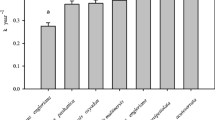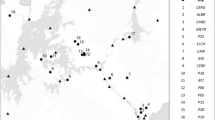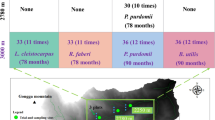Abstract
The Long-Term Intersite Decomposition Experiment in China (hereafter referred to as LTIDE-China) was established in 2002 to study how substrate quality and macroclimate factors affect leaf litter decomposition. The LTIDE-China includes a wide variety of natural and managed ecosystems, consisting of 12 forest types (eight regional broadleaf forests, three needle-leaf plantations and one broadleaf plantation) at eight locations across China. Samples of mixed leaf litter from the south subtropical evergreen broadleaf forest in Dinghushan (referred to as the DHS sample) were translocated to all 12 forest types. The leaf litter from each of other 11 forest types was placed in its original forest to enable comparison of decomposition rates of DHS and local litters. The experiment lasted for 30 months, involving collection of litterbags from each site every 3 months. Our results show that annual decomposition rate-constants, as represented by regression fitted k-values, ranged from 0.169 to 1.454/year. Climatic factors control the decomposition rate, in which mean annual temperature and annual actual evapotranspiration are dominant and mean annual precipitation is subordinate. Initial C/N and N/P ratios were demonstrated to be important factors of regulating litter decomposition rate. Decomposition process may apparently be divided into two phases controlled by different factors. In our study, 0.75 years is believed to be the dividing line of the two phases. The fact that decomposition rates of DHS litters were slower than those of local litters may have been resulted from the acclimation of local decomposer communities to extraneous substrate.







Similar content being viewed by others
References
Aber JD, Melillo JM, McClaugherty CA (1990) Predicting long-term patterns of mass loss, nitrogen dynamics, and soil organic matter formation from initial fine litter chemistry in temperate forest ecosystems. Can J Bot 68:2201–2208
Aerts R (1997) Climate, leaf litter chemistry and leaf litter decomposition in terrestrial ecosystems: a triangular relationship. Oikos 79:439–449
Chapin FS III, Shaver GR (1996) Physiological and growth responses of arctic plants to a field experimental simulating climatic change. Ecology 77:822–840
Coûteaux MM, Bottner P, Berg B (1995) Litter decomposition, climate and litter quality. Trends Ecol Evol 10:63–66
Gholz HL, Wedin DA, Smitherman SM, Harmon ME, Parton WJ (2000) Long-term dynamics of pine and hardwood litter in contrasting environments: toward a global model of decomposition. Glob Chang Biol 6:751–765
Helland IS (1987) On the interpretation and use of R2 in regression analysis. Biometrics 43:61–69
Heneghan L, Coleman DC, Zou X, Crossley DA Jr, Haines BL (1998) Soil microarthropod community structure and litter decomposition dynamics: a study of tropical and temperate sites. Appl Soil Ecol 9:33–38
Li KX (2007) Effects of nitrogen deposition on litter decomposition of two main coniferous tree species in Changbai mountain. J Northeast For Univ 35(2):17–19
Li XF, Han SJ, Zhang Y (2007) Foliar decomposition in a broadleaf-mixed Korean pine (Pinus koraiensis Sieb. Et Zucc) plantation forest: the impact of initial litter quality and the decomposition of three kinds of organic matter fraction on mass loss and nutrient release rates. Plant Soil 295:151–167
McHale PJ, Mitchell MJ, Bowles FP (1998) Soil warming in northern hardwood forest: trace gas fluxes and leaf litter decomposition. Can J For Res 28:1365–1372
Melillo JM, Aber JD, Muratore JF (1982) Nitrogen and lignin control of hardwood leaf litter decomposition dynamics. Ecology 63:621–626
Meentemeyer V (1984) The geography of organic decomposition rates. Ann Assoc Am Geogr 74:551–560
Moore B, Braswell III (1994) Planetary metabolism: understanding the carbon cycle. Ambio 23:4–12
Moorhead DL, Currie WS, Rasttetter EB, Parton WJ, Harmon ME (1999) Climate and litter quality controls on decomposition: an analysis of modeling approaches. Glob Biogeochem Cycles 13:575–589
Motulsky HJ, Christopoulos A (2003) Fitting models to biological data using linear and nonlinear regression: a practical guide to curve fitting. GraphPad Software Inc., San Diego, pp 34–35
Olson JS (1963) Energy stores and the balance of producers and decomposers in ecological systems. Ecology 44:322–331
Parton W, Silver WL, Burke IC, Grassens L, Harmon ME, Currie WS et al (2007) Global-scale similarities in nitrogen release patterns during long-term decomposition. Science 315:361–364
Prescott CE (2005) Do rates of litter decomposition tell us anything we really need to know? For Ecol Manag 220:66–74
Schlesinger WH (1991) Biogeochemistry: an analysis of global change. Academic, New York
Seastedt TR, Crossley DA, Meentemeyer V Jr, Waide JB (1983) A two-year study of leaf litter decomposition as related to macroclimatic factors and microarthropod abundance in the southern Appalachians. Holarct Ecol 6:11–16
Shaw MR, Harte J (2001) Control of litter decomposition in a subalpine meadow-sagebrush steppe ecotone under climate change. Ecol Appl 11(4):1206–1223
Silver WL, Miya RK (2001) Global patterns in root decomposition: comparisons of climate and litter quality. Oecologia 129:407–419
Taylor BR, Parkinson D (1988a) A new microcosm approach to litter decomposition studies. Can J Bot 66:1933–1939
Taylor BR, Parkinson D (1988b) Respiration and mass loss rates of aspen and pine leaf litter decomposing in laboratory microcosms. Can J Bot 66:1948–1959
Taylor BR, Parkinson D, Parsons WFJ (1989) Nitrogen and lignin content as predictors of litter decomposition rates: a microcosm test. Ecology 70(1):97–104
Vitousek PM, Turner DR, Parton WJ, Sanford RL (1994) Litter decomposition on the Mauna Loa environmental matrix, Hawaii: patterns, mechanisms, and models. Ecology 75(2):418–429
Wang J, Huang JH (2001) Comparison of major nutrient release patterns in leaf litter decomposition in warm temperate zone of China. Acta Phytoecologica Sinica 25(3):375–380
Wardle DA, Walker LR, Bardgett RD (2004) Ecosystem properties and forest decline in contrasting long-term chronosequences. Science 305:509–513
Xu XJ, Zhang K, Liu B, Lan CC, Xu XN (2007) Review on litter decomposition in forest ecosystems. Sci Soil Water Conserv 5(4):108–114
Zhang DQ, Yu QF, Kong GH, Zhang YC (1998) Chemical properties of forest floor litter in Dinghushan monsoon evergreen broadleaved forest. Acta Ecol Sin 18(1):96–100
Zhou GY, Sun G, Wang X, Zhou CY, McNulty SG, Vose JM et al (2008) Estimating forest ecosystem evapotranspiration at multiple temporal scales with a dimension analysis approach. J Am Water Resour Assoc 44(1):208–221
Acknowledgements
The LTIDE study was funded by NSFC projects 30725006 and 40730102 and CERN. We thank Drs. Li Yide, Wang Silong, Tang Jianwei, Sang Weiguo, Guo Qingxi, Liu Yuhong, and Cheng Genwei for their assistance in field data collection.
Author information
Authors and Affiliations
Corresponding author
Additional information
Responsible Editor: Alfonso Escudero.
Rights and permissions
About this article
Cite this article
Zhou, G., Guan, L., Wei, X. et al. Factors influencing leaf litter decomposition: an intersite decomposition experiment across China. Plant Soil 311, 61–72 (2008). https://doi.org/10.1007/s11104-008-9658-5
Received:
Accepted:
Published:
Issue Date:
DOI: https://doi.org/10.1007/s11104-008-9658-5




